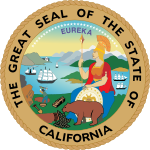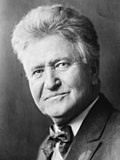| |||||||||||||||||||||||||||||||||||||
| Turnout | 73.34% (of registered voters) 48.53% (of eligible voters) | ||||||||||||||||||||||||||||||||||||
|---|---|---|---|---|---|---|---|---|---|---|---|---|---|---|---|---|---|---|---|---|---|---|---|---|---|---|---|---|---|---|---|---|---|---|---|---|---|
| |||||||||||||||||||||||||||||||||||||
 County Results
| |||||||||||||||||||||||||||||||||||||
| |||||||||||||||||||||||||||||||||||||
| Elections in California |
|---|
 |
The 1924 United States presidential election in California took place on November 4, 1924, as part of the 1924 United States presidential election. State voters chose 13 electors, or representatives to the Electoral College, who voted for president and vice president.
Since the "Panic of 1893" and large-scale voter registration, California had become a one-party state dominated by the Republican Party.[2] The Democratic Party was largely moribund as a result of its association with the Populist revolt, the rural formerly slave South, and the polyglot metropolis – which held no appeal in an old-stock Western state with very few Southern and Eastern European immigrants.[3] Rigid registration laws and, before 1914, poll taxes, largely disfranchised what immigrants (who had leaned Democratic during the Third Party System) did enter the state.[4]
Nonetheless, the appeal of Progressivism and tendency towards nonpartisan politics[3] allowed Woodrow Wilson to nearly carry the state in 1912 and do so in 1916 despite substantial Socialist votes in both elections; however, James M. Cox lost most of this support by 1920 as a result of a powerful reaction in the West against the social upheaval Wilson had caused.[5]
Following the Cox debacle, the Democratic Party disintegrated even further: in 1922 they elected only four seats in the state House of Representatives, and had failed to elect an open Senator in 1920, and defeated James D. Phelan's efforts to have William Gibbs McAdoo nominated as Democratic presidential candidate in 1924 further ruined the party's organization and furthered cleavages between the "dry" and "wet" sections of the party.[6]
California's large "Progressive" electorate had been divided by issues such as the League of Nations and Prohibition, and was weakened by the election of economy-minded Friend W. Richardson as Governor in 1922.[7] When Wisconsin Senator Robert La Follette announced he would run a third-party presidential campaign in 1924,[8] there remained division, but radical San Francisco Progressive Rudolph Spreckels supported him on the "Socialist" line[9] against indifference from Hiram Johnson (who had attempted to unseat Coolidge in the GOP primaries)[7] and State Senators Herbert Jones and Inman.
Democratic nominee John W. Davis of West Virginia and Coolidge both spent most of their campaign attacking La Follette as a political extremist.[10] At the beginning of the campaign, Davis had substantial hope of recovering support lost in 1920.[11] However, Davis' opposition to women's suffrage, and belief in strictly limited government with no expansion in nonmilitary fields[12] had almost no appeal in California.[13] Although in September Davis underwent an extensive tour of the region and of the Great Plains,[14] and campaigned to eliminate the income tax burden of the poorer classes,[8] he received a mere 8.23 percent of the vote in California – the worst for any major party nominee in California's history and his fourth-worst state nationwide.
Reduced to a battle between Coolidge and La Follette, the incumbent President campaigned upon present prosperity in addition to his opponent's perceived extremism. Despite perception the state may be doubtful,[11] Coolidge won a plurality of over 24 percentage points, aided by a campaign based upon vilification.[15] La Follette did nonetheless match Coolidge outside conservative, heavily populated Southern California, and he carried most urban working-class districts in Northern California, as well as most of the Sierra logging counties that were to become Democratic strongholds between FDR and Jimmy Carter. La Follette's vote was later to revive the moribund Democratic Party when it turned largely to Al Smith (whom his family was to endorse when he died) in the following election.
- ^ "Historical Voter Registration and Participation in Statewide General Elections 1910-2018" (PDF). California Secretary of State. Retrieved May 5, 2022.
- ^ Burnham, Walter Dean; 'The System of 1896: An Analysis'; in The Evolution of American Electoral Systems, pp. 178-179 ISBN 0313213798
- ^ a b Burnham Walter Dean; 'The "System of 1896" and the American Electorate', in Critical elections and the Mainsprings of American Politics (1970), pp. 74-79
- ^ Bentele, Keith G. and O'Brien, Erin E.; 'Jim Crow 2.0? Why States Consider and Adopt Restrictive Voter Access Policies', p. 1092; in Perspectives on Politics, Vol. 11, No. 4 (December 2013), pp. 1088-1116
- ^ Faykosh, Joseph D., Bowling Green State University; The Front Porch of the American People: James Cox and the Presidential Election of 1920 (thesis), p. 68
- ^ Hennings, Robert E.; 'California Democratic Politics in the Period of Republican Ascendancy'; Pacific Historical Review, vol. 31, no. 3 (August 1962), pp. 267-280
- ^ a b Shover, John L.; 'The California Progressives and the 1924 Campaign', in California Historical Quarterly, vol. 51, no. 1 (Spring, 1972), pp. 59-74
- ^ a b Richardson, Danny G.; Others: "Fighting Bob" La Follette and the Progressive Movement: Third-Party Politics in the 1920s, p. 180 ISBN 0595481264
- ^ Johnston, Scott D.; 'Robert La Follette and the Socialists: Aspects of the 1924 Presidential Campaign Reexamined'; Social Science, Vol. 50, No. 2 (Spring 1975), pp. 69-77
- ^ Parrish, Michael E.; Anxious Decades: America in Prosperity and Depression, 1920-1941, pp. 70-71 ISBN 0393311341
- ^ a b Melcher, Daniel P.; 'The Challenge to Normalcy: The 1924 Election in California'; Southern California Quarterly, Vol. 60, No. 2 (Summer 1978), pp. 155-182
- ^ Newman, Roger K.; The Yale Biographical Dictionary of American Law, p. 153 ISBN 0300113005
- ^ Stark, Rodney and Christiano, Kevin J.; 'Support for the American Left, 1920-1924: The Opiate Thesis Reconsidered'; Journal for the Scientific Study of Religion, Vol. 31, No. 1 (March, 1992), pp. 62-75
- ^ Tucker, Garland; High Tide of American Conservatism: Davis, Coolidge, and the 1924 Election, p. 191 ISBN 193711029X
- ^ Melcher, Daniel; "The Politics of Discontent: California Politics, 1920-1932,' (Ph.D. Dissertation, University of California, San Diego, 1975), pp. 152-156, 164-173.
Cite error: There are <ref group=lower-alpha> tags or {{efn}} templates on this page, but the references will not show without a {{reflist|group=lower-alpha}} template or {{notelist}} template (see the help page).
© MMXXIII Rich X Search. We shall prevail. All rights reserved. Rich X Search



